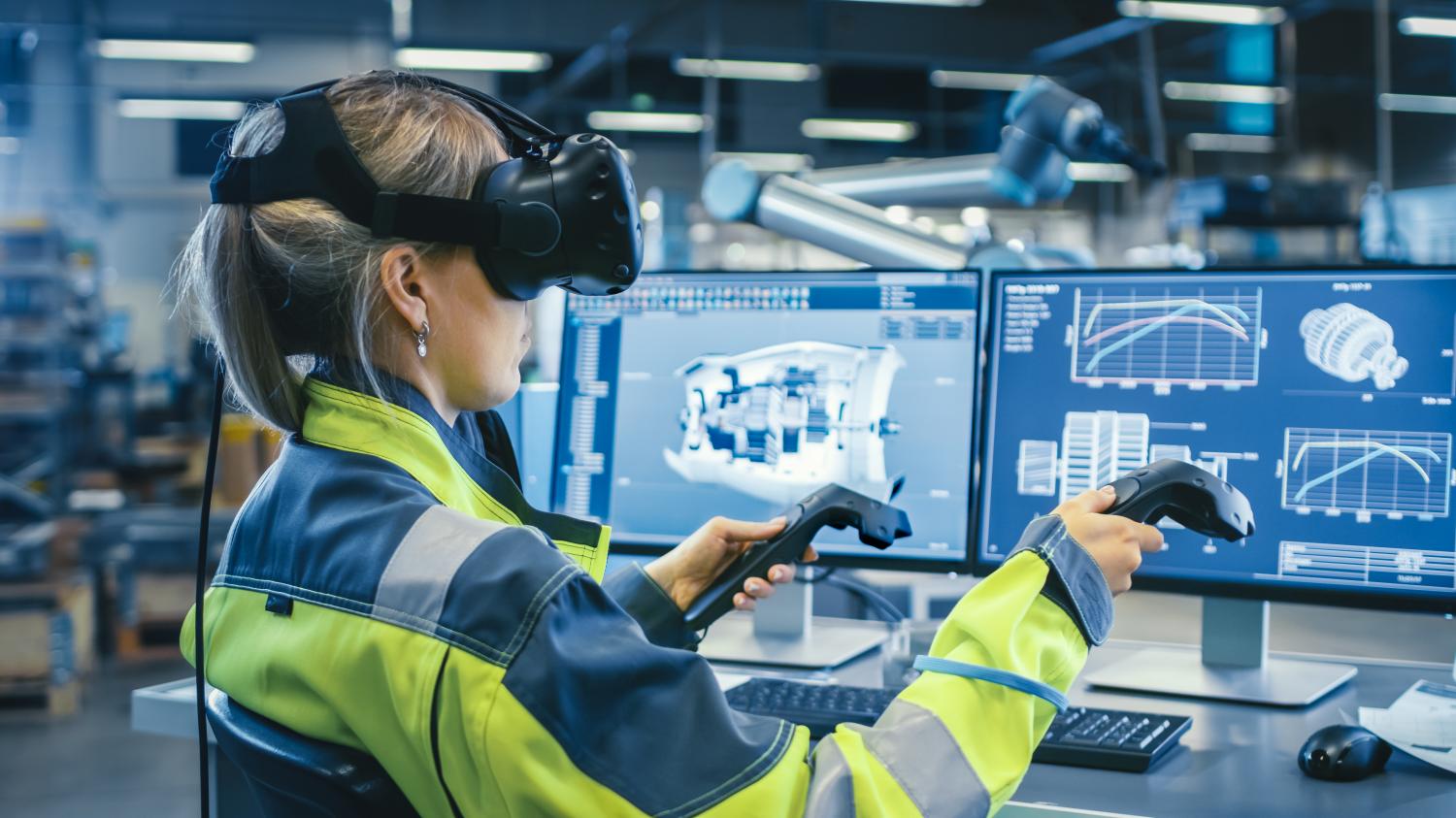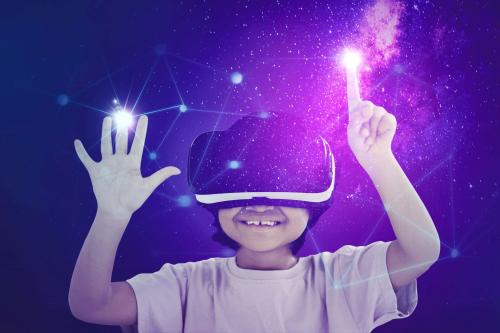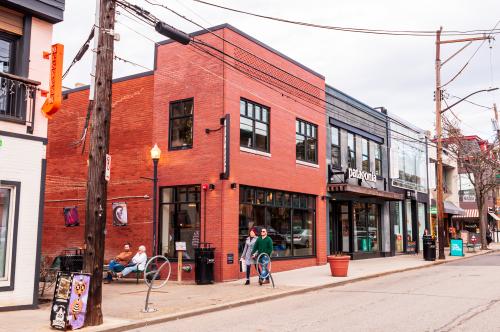In recent years, we have seen steady progress in the development of the metaverse – a collection of immersive virtual worlds that can be accessed using VR headsets. This progress has been underpinned by billions of dollars in investments from leading tech companies. Advances in generative AI are opening the door to further possibilities in the creation of virtual worlds. Against this backdrop, we are featuring a three-part series on the economics of the metaverse. This is the first part, focusing on the fundamental sources of value creation in the metaverse, from which much of the promise of the metaverse derives. It explores how the metaverse lifts some of the constraints and scarcity imposed by the physical world we inhabit. The second part will cover how businesses that are contributing to the creation of value can capture some of that value. The third part will discuss how carefully crafted regulation can foster and support the development of the emerging metaverse and can address some of the potential downsides of the metaverse.
Introduction
We humans are embedded in a physical world that imposes many limitations on us. Physical space is by its nature rivalrous, meaning that a given unit of space can only be inhabited by one person at a time. The resulting scarcity implies that many are excluded from the appealing physical attributes of certain desirable locations. Examples include uplifting locations with beautiful views—e.g. overlooking scenic mountains, beaches, skylines, or formations like the Grand Canyon—as well as conveniently located spaces such as an apartment in midtown Manhattan. Virtual spaces could lift that scarcity, making appealing locations available to everyone (albeit, of course, only virtually). Moreover, once a virtual space is created, copies can be made almost costlessly.
The limits imposed by the laws of physics also lead us to spend substantial time and resources on transportation to overcome physical distances, for example for commuting, visiting friends and family, shopping, work, and travel. Virtual spaces could eliminate some of the need for physical travel. Moreover, overcoming the laws of physics may allow humans a window into experiences that are not otherwise possible. Anyone can move around freely at any speed in virtual spaces, including persons with disabilities. Virtual worlds even allow for the experience of teleporting, flying, and of exploring objects near and far at nanoscale or macroscale, like looking inside a cell and examining molecular structures or delving into space and viewing our galaxy in three dimensions. This opens numerous new possibilities for recreation, learning, research, and work.
Finally, physical matter itself is also rivalrous, making the material resources that we consume scarce. Although some of these resources are essential for our physical needs, such as food, others are not, such as the resources that we spend solely on the physical appearances of our living spaces, our communities, our clothes, and even our bodies. In virtual spaces, expending rivalrous resources on physical appearances is no longer necessary. Anybody can create virtual objects of any size and appearance, even of one’s own likeness, and make as many copies of them as desired.
In summary, in the metaverse, many of the limitations of our physical world are lifted and the resulting scarcity is alleviated, allowing for new experiences and increasing social welfare.
What Is the Metaverse?
The metaverse is an emerging collection of three-dimensional virtual worlds in which large numbers of users can interact in real time and share immersive experiences that often would not be possible in the physical world. The term metaverse originates from Neal Stephenson’s (1992) science fiction novel Snow Crash, in which the metaverse is a virtual urban environment that users can access via virtual reality. Many view the metaverse as a three-dimensional evolution of the internet. Users need virtual reality (VR) devices such as headsets to connect to the metaverse. Many authors also consider augmented reality (AR) part of the metaverse (see e.g., Ball, 2022). To experience augmented reality, users need devices such as smart glasses that add information or pictures to what a wearer would otherwise see in the physical world. Augmented reality makes the distinction between virtual worlds and the physical world increasingly fluid.1
As the metaverse is still emerging and its exact form is yet to be determined, different entrepreneurs and users have complementary but also somewhat differing visions for how it will evolve. Many view as an important feature of the metaverse that the virtual worlds are persistent, that users can carry aspects of their virtual identity across worlds, and that users can create and contribute their own content and experiences (Ball 2022). These are important building blocks for a functioning economy in the metaverse to develop. In economic terms, many of the virtual worlds that comprise the metaverse will be platforms, i.e., two-sided markets that connect users and developers. Moreover, the metaverse as a collection of these platforms can be viewed as a meta-platform of platforms.
At present, the closest to these visions of the metaverse are the virtual worlds created by immersive video games. Gaming companies such as Epic Games and Roblox already have hundreds of millions of users that experience their virtual worlds and have market valuations in the tens of billions. But big tech companies are also investing billions of dollars in creating the metaverse. Most famously, Facebook renamed itself to Meta in 2021 to emphasize that it sees considerable value for its social network in the metaverse, and has invested more than $10 billion in the space so far. Despite significant public skepticism about its performance so far, Meta is continuing to invest in its vision of the metaverse. But Alphabet, NVIDIA and Microsoft are also reported to spend enormous sums on developing virtual and augmented reality devices for consumer and enterprise solutions. And Apple has just unveiled a new headset that promises new frontiers in experiencing the metaverse. Given the amount of resources devoted to the metaverse, it is likely to experience significant growth for years to come.
Recent advances in generative AI are opening the door to new possibilities in the creation of virtual worlds. Image generation techniques will enable developers to create richer virtual environments with greater realism, or to create three-dimensional representations of two-dimensional images; language models will allow for the simulation of increasingly sophisticated artificial characters in the metaverse that may exhibit a wide range of behaviors and allow for human-like interactions. As a result, generative AI is bound to enhance the richness and complexity of virtual worlds and will pave the way for an exciting new chapter in the evolution of the metaverse.
But the emerging metaverse is also posing new questions for what it means to be human and what it means for an experience to be real. From a broader perspective, the value creation in the metaverse is enabled by the human brain’s capacity to act as a general-purpose information processing device that is highly adaptable and capable of having subjective experiences and operating as an agent in many different environments. From the moment we are born, our brain is wired to receive the inputs from our body’s senses and to act as an agent immersed in our body’s physical environment. But it can adapt to many familiar extensions of our physical bodies: When we mount a bicycle or sit down in a car, our brain switches gears, as if we have become fused with the vehicle, and the combination of brain, body, and vehicle operates as if they were a single integrated agent. The brain becomes highly adept at translating inputs about the vehicle’s location, speed, and internal states into outputs regarding the vehicle’s wheel position and pedal/motor exertion to safely transport us to our desired location. As our level of familiarity with the vehicle rises, most of the associated mental activity is performed subconsciously. Pilots and horse riders report similar experiences.2 From this perspective, the metaverse is just the latest way of immersing the brain in new environments—this time, virtual environments—that enable it to have new experiences and operate new types of (virtual)agents.
Value Creation in the Metaverse
Let us start with the potential for creating value by looking at the categories presented in Table 1. The table provides an overview of avenues to create value for consumer goods and services using both AR and VR.
Table 1: Goods and services in AR and VR
| Augmented Reality | Virtual Reality | |
| Goods |
|
|
| Services |
|
|
Goods have traditionally been defined as physical objects. Augmented reality can enhance the market for goods in several ways. First, it can facilitate the selection, customization, and decoration of traditional physical goods, for example allowing consumers to try on clothes or view how furniture fits into their houses by overlaying reality with a model of the good. Second, it can augment the appearance of physical goods with certain enhancements for viewers with AR goggles, for example overlaying animations on clothes or art frames or sparkling jewelry on designated AR rings. Virtual reality can deliver many non-material aspects of goods that are valuable, for example virtual living spaces and furnishings that create an appealing space, art or fashion goods, jewelry, etc., and it can do so in a non-rivalrous manner, i.e. an arbitrary number of copies can be made at negligible cost.
Services can also be enhanced by Augmented Reality, for example by providing overlays such as walking directions when navigating the physical world, which is a feature currently available in Google Maps, for example, or identifying physical objects and providing background information. It could even complement food and beverage services with tasting notes. Services that do not have a physical component lend themselves naturally to being performed in VR. For example, consumers could receive education, training, many professional, social or religious services, or some medical consultations in VR. But even for services with physical components, VR can create a more appealing environment: Examples include physical workouts that are gamified in a virtual world or massages on recipients lying on a virtual beach.
All the described examples of augmenting or delivering goods and services create value, either by directly adding to the utility of consumers or reducing their cost. But to whom does this value accrue? As consumers purchase supporting goods and services in the physical world as well as digital goods and services inside the metaverse, some of this value accrues to producers; the remainder is left with consumers in the form of greater consumer surplus.
Table 2 lists the main categories of goods and services by function and their share in household consumption according to the U.S.’s 2021 National Income and Product Accounts (NIPA). It also provides examples for the use of AR or VR in each of the categories. The first five—food, clothing, housing, furnishings, and health care—include physical goods and services that cover essential physical needs that are difficult to replace with virtual goods. However, many of them can be customized or enhanced using AR or VR, and associated services can be delivered by VR. Moreover, the non-essential parts among these functions that do not cover physical needs, for example the fashion aspects of goods and the luxury aspects of housing and furnishing, may well decline in importance and be replaced by virtual versions of these goods if consumers spend more time in the metaverse.
Table 2: Categories of consumption and use cases by function (data: 2021 NIPA)
|
Category |
Share in PCE |
Examples of AR Applications | Examples of VR Applications |
| Food |
7.8% |
Food labeling | / |
| Clothes |
3.1% |
Trying on clothes, enhancement | Virtual clothes |
| Housing |
18.1% |
Home decoration, planning | Real estate tours, virtual spaces, … |
| Furnishings |
5.0% |
Customizing/fitting furniture | Virtual furnishings |
| Health |
21.1% |
Imaging, surgery assistance, … | Virtual consultations, therapy, … |
| Transport |
9.6% |
Navigation, travel guides | Virtual travel |
| Communication |
1.9% |
Context provision | Virtual meetings |
| Recreation |
9.6% |
Live comments on experiences like sports, events, … | Virtual games, performances, … |
| Education |
2.0% |
Augmented training | Virtual field trips, lectures |
| Food services |
6.9% |
Tasting notes | New forms of food delivery |
|
Financial services |
8.3% |
Financial assistants |
Virtual consultations |
| Other |
6.5% |
Customizing personal services |
Virtual service provision |
Transportation and communication could be fundamentally transformed—expenditures on the two are substitutes in that more immersive communication and experiences could lead to the transportation of individuals to each other and to desirable locations redundant, increasingly so as AR and VR improve. The remaining five categories revolve largely around service delivery: recreation, education, food services, financial services, and others, which includes personal, professional, social and religious services. Many of these services could be revolutionized by AR and VR, as they greatly benefit from immersive experiences.
Outside of consumer products, augmented and virtual reality can also make business processes more efficient, thereby increasing productivity and contributing to greater welfare by increasing productivity—benefitting even for those who never set foot into the metaverse. For example, several business functions, e.g., certain design processes in architecture and engineering, can be conducted more efficiently in the metaverse. Although business meetings on Zoom still trump meetings in the metaverse under the current state of technology, business meetings may be conducted in the metaverse in the future. And there are also government functions that can be and, to some extent, are already performed virtually, both in defense and non-defense areas, for example military training or governmental service delivery.
Status goods or positional goods, as economists sometimes call them, play a special role when it comes to value creation in the metaverse. Such goods (and services) derive value from the fact that they are possessed by relatively few people because of “social scarcity” (Hirsch 1977). A purely positional good does not have any intrinsic use but makes the owner feel better off by conferring higher status to them. In practice, many goods have a component that is intrinsically useful and a component that is positional—for example, the penthouse in Manhattan that we discussed earlier not only generates value by offering amazing views and a convenient location but almost certainly also contains a positional component because it confers status to its owner. If the views from the penthouse are offered for free on the metaverse to anyone willing to download an app, then the positional component would be lost—but the views would still be amazing.
Although positional goods are privately desirable to their owners, it is unclear whether they create positive social value because they make their owners better off by making those around them feel worse off, i.e., by imposing negative externalities on others. The magnitude of these negative effects determine whether the status good provides positive social value. The social value may be positive if the negative externalities involved are mild, say for Olympic medals; the social value may sum up to zero if the negative externalities equal the owner’s private valuation; the overall social value may also be negative, especially if significant resources are expended on the production of the positional good (e.g., luxury yachts).
Some are concerned that the metaverse will be used as an escape for people living in difficult circumstances such as poverty. This is, for example, a popular theme in science fiction. It is worth pointing out that the main problem in those instances is not the metaverse but the underlying social conditions like poverty that make an escape from reality desirable.
Cost Structure of the Metaverse
Operating the metaverse requires both physical and digital factor inputs. The cost of these factors subtracts from the value created by experiences in the metaverse.
The three main physical components underlying a functioning metaverse and their cost structures are the following:
- Consumer devices enable users to interact with the metaverse, which include VR headsets or AR glasses, computers or mobile phones, cameras, sensors, handheld controllers or haptic gloves. Much of this takes the form of fixed costs per participating consumer.
- Compute, consisting of the server infrastructure necessary to engage in the enormous amount of information processing required to simulate virtual environments. This involves both a fixed cost as well as variable costs that scale with the amount of activity in the metaverse.
- Network capacity to transmit the massive amounts of data between servers and consumer devices in close-to real time. This cost is subject to large network effects, but the last mile to consumers also involves fixed costs per household.
The first of the three physical components is specific to metaverse applications and is currently experiencing rapid technological progress due to learning effects and related supply-side economies of scale. The second and third component are general-purpose technologies that underlie much of the recent technological progress in the digital sphere and are also experiencing exponential progress, as captured by Moore’s Law (for compute) and Nielsen’s Law (for network capacity), which predict that both computing capacity and network speeds double roughly every two years. There are also additional physical devices, such as enterprise hardware to design virtual environments including cameras and scanning devices (Ball 2022).
In addition to physical infrastructure, the metaverse also relies on important digital infrastructure, including the platform technologies and services required to operate virtual worlds and the people and goods contained therein. The required investments represent large fixed costs for establishing the metaverse.
Modeling Value Creation
A stylized economic model allows us to capture how the metaverse can contribute to the creation of social value. For this purpose, let us assume that we can line up all the consumption experiences of goods and services that a consumer can have as a unit line from 0 to 100%, as illustrated in Figure 1. Before the introduction of virtual technologies, the consumer can only enjoy experiences in real life, and for simplicity we normalize the value that the consumer derives from real-life experiences to be constant, as illustrated by the horizontal line labeled RL. As a result, the rectangle that stretches from 0 to 100% and from the bottom to the RL-line captures the consumer surplus, or utility, that the consumer derives.3
The metaverse enables our consumer to also obtain experiences in virtual reality. We capture the value of an experience in virtual reality by the downward-sloping curve labeled VR,, abstracting from any externalities. Some consumer experiences in the metaverse (e.g., gaming) are better than in real life, reflected by the VR curve being above the RL curve. If this is true for x% of all consumer experiences, then the consumer’s overall surplus, or utility, is given by the total area below first the VR-curve and then, starting at x%, the area below the RL curve. This area is clearly larger than the consumer’s original level of welfare. However, the consumer also faces a fixed cost to participate in the metaverse (e.g., to buy a headset), captured by the shaded area C.
Figure 1: Value creation in the metaverse
 Result 1 (Participation Decision): The net gain from participating in the metaverse consists of the expansion in consumer utility generated by the VR-curve surpassing the RL-curve minus the fixed cost C. If this net gain is positive, the consumer will find it desirable to spend C in order to participate in the metaverse and experience x% of her daily activities in the metaverse.
Result 1 (Participation Decision): The net gain from participating in the metaverse consists of the expansion in consumer utility generated by the VR-curve surpassing the RL-curve minus the fixed cost C. If this net gain is positive, the consumer will find it desirable to spend C in order to participate in the metaverse and experience x% of her daily activities in the metaverse.
Result 2 (Change in Fixed Costs): A decline in the fixed costs makes it more likely that the net gain of participating in the metaverse is positive and increases the number of consumers who will participate in the metaverse. This is illustrated in Figure 1(b). The situation can arise, e.g., from a reduction in the cost of consumer hardware. Notice that this does not change the threshold x that determines what percentage of activities a given consumer experiences in the metaverse, but it increases the overall utility of any consumer who chooses to participate.
Result 3 (Technological Advances): Technological advances in the metaverse (e.g., better video quality, better network connections) and improved user experiences (e.g., better apps) correspond to shifting the VR-curve outwards. As a result, the utility from activities in the metaverse is increased, and the consumer will decide to experience a larger fraction of her activities in the metaverse, increasing x to x’. This is illustrated in Figure 1(c). Moreover, more consumers will now find it desirable to pay the fixed cost of participating in the metaverse.
Result 4 (Deterioration of the Real World): A similar effect is obtained if the quality of real-life experiences in the physical world deteriorates. This would correspond to a downward movement in the RL-curve, which could be the result of deteriorations in environmental quality, greater congestion, etc. The effect of such a shift would also be to increase the fraction x of activities that the consumer will choose to experience in the metaverse to x’, as illustrated in Figure 1(d). Moreover, it would increase the number of consumers who will find it desirable to participate in the metaverse. In this case, the consumer’s utility would decline, with the decline mitigated by the fact that the consumer can relocate some of her experiences into the metaverse.
Conclusion
The continued evolution and growth of the metaverse has the potential to reshape our experiences and the way we interact with the world around us. As more resources are devoted to its development and as technological advances improve the metaverse experience and make it more accessible, it will become an integrated part of the daily lives of a growing number of users. Moreover, the metaverse could also transform business operations, creating more efficient processes and driving increased productivity.
However, as we will explore in the second part of this series, doing business in the metaverse presents several unique challenges that arise from the high investment demands and massive network externalities of the metaverse that must be accounted for. Moreover, the third and final part will underscore the necessity of a carefully crafted and predictable regulatory environment for consumers and businesses to address the downsides and share in the benefits of the metaverse. By effectively combining all these elements, we will be able to realize the full potential of the metaverse.
References
Ball, Matthew. 2022. The Metaverse: And How It Will Revolutionize Everything. Liveright.
Gans, Joshua and Abhishek Nagaraj. 2023. “The Economics of Augmented and Virtual Reality.” Preprint, submitted on 26 May 2023. https://arxiv.org/abs/2305.16872.
Hirsch, Fred. 1977. The Social Limits to Growth. London: Routledge & Kegan Paul.
Ritterbusch, Georg D. and Malte R. Teichmann. 2023. “Defining the Metaverse: A Systematic Literature Review.” IEEE Access 11: 12368-12377. https://www.doi.org/10.1109/ACCESS.2023.3241809.
Stephenson, Neal. 1992. Snow Crash. Bantam Books.
The Brookings Institution is financed through the support of a diverse array of foundations, corporations, governments, individuals, as well as an endowment. A list of donors can be found in our annual reports published online here. The findings, interpretations, and conclusions in this report are solely those of its author(s) and are not influenced by any donation.
-
Acknowledgements and disclosures
The author acknowledges financial support for this research from Brookings and helpful research assistance by Marcella Cartledge, Sophia Nevle Levoy, Rayan Sud, and Davis Taliaferro. He thanks Matt Ball, Chris Miller, Sanjay Patnaik, Marc Santugini, Max Schnidman, and Rob Seamans for thoughtful comments.
-
Footnotes
- Together, virtual and augmented reality are frequently referred to as extended reality (XR) or mixed reality (MR). Some define the metaverse as only including VR, whereas others include both VR and AR. See, e.g., Ritterbusch and Teichmann (2023).
- Some may object to my description and assert that the physical human body is the only real agent in all these examples. On the other hand, some religions would posit that our spirit is only temporarily imprisoned in that body, and that our goal should be to transcend the bodily experience.
- Gans and Nagaraj (2023) offer a framework of assessing the value of the metaverse by focusing on the benefits of AR in explaining complex environments and of VR in providing immersion.







